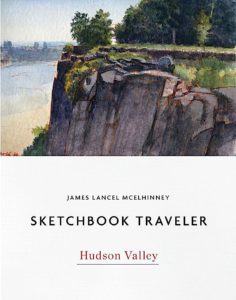Waiting for the crisis to pass, our thoughts go out to friends and loved-ones who also shelter in place. Old friends pass away, people we loved and admired. Immobilized for the time being, we can revisit destinations, near and far. join me in celebrating the joys of Quaranteam travel, the hope that these diversions might inspire us to value things we had taken for granted, to draw strength, wisdom and compassion from deeper engagements with nature.

Butter Hill from Cold Spring. Tuesday July 4, 2017.
. (Image and text were featured in the exhibition James McElhinney. Discover the Hudson Anew, curated by Laura Vookles. Hudson River Museum. Yonkers, New York. September 13, 2019 to February 16, 2020. Published also as a limited-edition in Hudson Highlands. North River Suite Volume One. Needlewatcher Editions. New York. 2018)
The Dutch named Boterberg (Butter Hill), the mountain on the right, because it resembled a butter loaf. Rising more than 1,300 feet above the river, Butter Hill is formed of Proterozoic granite and gneiss distorted by plate tectonics. Its present form was sculpted between 100,000 and 120,000 years ago by glaciation that sheared off its southern slope to expose the rock face visible today. The Hudson Highlands ranks as one of America’s two fjords. The other, Somes Sound at Mount Desert Island in Maine, is where I first witnessed similar evidence of glacial activity smoothing one side of a geological uplift and tumbling down the other. Taking up residence north of Butter Hill, poet and critic Nathaniel Parker Willis named his hilltop estate Idlewild. In an age when explorers crisscrossed the globe naming every rock, tree, and puddle, Butter Hill did not sit well with Willis who, in today’s parlance, gave it a better brand.
“Standing aloft before other mountains in the chain, this sign is peculiar to him. He seems the monarch, and this seems his stately ordering of a change in the weather. Should not STORM-KING, then, be his proper title?”

Storm King, at The Wind-Gate of the Hudson Highlands. Wednesday November 8, 2017.
Beginning in 1963, Consolidated Edison began efforts to construct an auxiliary power-plant at Storm King Mountain. The facility would require the construction of a reservoir at the summit. During emergencies, water could be released through turbines generating electricity to compensate for any temporary shortages. Authorization by the Federal Power Commission in 1970 sparked a firestorm of protest, galvanizing the American environmental movement in year to first celebrate Earth Day. Built two years prior, Hudson River Sloop Clearwater promotes environmental awareness by advocating for the protection of Hudson Valley wetlands and waterways through education and public programs. Pete Seeger’s introduction to the Y2K reprint of Benson Lossing’s 1866 The Hudson from the Wilderness to the Sea seem prescient. In the grip of a pandemic, he might be tempted to say the chickens have come home to roost.
“…as the world trembles on the brink of a population explosion, threatened by scientific inventions we don’t know how to handle, it’s worth dipping into this old-time world and contemplating how it has changed—but in some ways has not. The human heart still behaves much the same. The sun, moon and stars still attend their rounds, and birds and flowers, though threatened, still survive in some places. If we know better what has gone before, we can better plan for what we hope is to come.”

April Dispatches are all now online. Thirty-one episodes,
presented in a user-friendly calendar view interface. Enjoy!
(A preview of SKETCHBOOK TRAVELER by James L. McElhinney (c) 2020. Schiffer Publishing).
Copyright James Lancel McElhinney (c) 2020 Texts and images may be reproduced (with proper citation) by permission of the author. To enquire, send a request to editions@needlewatcher.com
